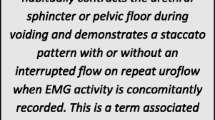Abstract
Background
Up to 50% of children with vesicoureteral reflux (VUR) may have associated voiding dysfunction. It is thought to be an important determinate of the severity and resolution of VUR; however, to date there has been no objective measurement defining the impact of voiding dysfunction in children with VUR. The purpose of this study is to compare the urodynamic parameters of children with VUR who have and do not have symptomatic voiding dysfunction.
Methods
We performed a retrospective study of 138 children with a diagnosis of primary VUR who underwent urodynamic investigations. Information regarding patient demographics, grade and laterality of VUR and clinical history of bladder dysfunction were assessed. Urodynamic parameters recorded included detrusor overactivity, early and late compliance, voiding pressure, post-void residual volume and functional bladder capacity. Statistical analysis was performed using t Student analysis, Pearson’s χ2 test or Fischer’s exact test, with a p < 0.05 as being significant.
Results
The mean age of the patients at the time of urodynamic evaluation was 5.8 years (SD 4.4). 30% had symptomatic voiding dysfunction based on the clinical history. Children without a history of voiding dysfunction had higher grades of VUR as compared to those with it (p = 0.002). Bladder hypertone, detrusor overactivity, detrusor hypereflexia and poor late bladder compliance presented a statistically significant higher incidence the incidence of bladder overactivity and poor late bladder compliance was higher in children with bladder dysfunction than those without it.
Conclusion
Our findings suggest that voiding dysfunction does have objective and quantifiable effects on bladder dynamics. Urodynamic evaluation may play a role in the management of children with VUR by identifying those with bladder dysfunction secondary to abnormal voiding habits.




Similar content being viewed by others
References
Koff SA, Wagner TT, Jayanthi VR (1998) The relationship among dysfunctional elimination syndromes, primary vesicoureteral reflux and urinary tract infections in children. J Urol 160:1019
Scholtmeijer RJ, Nijman RJ (1994) Vesicoureteric reflux and videourodynamic studies: results of a prospective study after three years of follow-up. Urology 43:714
Yeung CK, Sreedhar B, Sihoe JD et al (2006) Renal and bladder functional status at diagnosis as predictive factors for the outcome of primary vesicoureteral reflux in children. J Urol 176:1152
van Gool JD, Hjalmas K, Tamminen-Mobius T et al (1992) Historical clues to the complex of dysfunctional voiding, urinary tract infection and vesicoureteral reflux. The International Reflux Study in Children. J Urol 148:1699
Snodgrass W (1998) The impact of treated dysfunctional voiding on the nonsurgical management of vesicoureteral reflux. J Urol 160:1823
Homayoon K, Chen JJ, Cummings JM et al (2005) Voiding dysfunction: outcome in infants with congenital vesicoureteral reflux. Urology 66:1091
Greenfield SP, Wan J (2000) The relationship between dysfunctional voiding and congenital vesicoureteral reflux. Curr Opin Urol 10(6):607–610
Capozza N, Lais A, Matarazzo E, Nappo S, Patricolo M, Caione P (2002) Influence of voiding dysfunction on the outcome of endoscopic treatment for vesico-ureteral reflux. J Urol 168:1695–1698
Izquierdo RM, Mialdea Luque (2008) Evaluation of the lower urinary tract function in pediatric patients with primary vesicoureteral reflux. Arch Esp Urol 61(2):191–207
McLellan A, Cardozo L (2001) Urodynamic techniques. Int Urogynecol J Pelvic Floor Dysfunct 12(4):266–270 (review)
Chandra M (1995) Reflux nephropathy, urinary tract infection, and voiding disorders. Curr Opin Pediatr 7(2):164–170
Griffiths DJ, Scholtmeijer RJ (1987) Vesicoureteral reflux and lower urinary tract dysfunction: evidence for 2 different reflux/dysfunction complexes. J Urol 137:240
Lapointe SP, Barrieras D (2004) Normal urodynamic parameters in children. In: Corcos J, Schick E (eds) The textbook of the neurogenic bladder. Marin Dunitz Ltd., London, pp 409–414
Jansson UB, Hanson M, Hanson E et al (2000) Voiding pattern in healthy children 0 to 3 years old: a longitudinal study. J Urol 164:2050
Ural Z, Ulman I, Avanoglu A (2008) Bladder dynamics and vesicoureteral reflux: factors associated with idiopathic lower urinary tract dysfunction in children. J Urol 179(4):1564–1567 (Epub 4 Mar 2008)
Acar B, Arikan FI, Germiyanoğlu C, Dallar Y (2009) Influence of high bladder pressure on vesicoureteral reflux and its resolution. Urol Int 82(1):77–80 (Epub 20 Jan 2009)
Capozza N, Caione P (2002) Dextranomer/hyaluronic acid copolymer implantation for vesico-ureteral reflux: a randomized comparison with antibiotic prophylaxis. J Pediatr 140(2):230–234
Capozza N, Lais A, Nappo S, Caione P (2004) The role of endoscopic treatment of vesico-ureteral reflux. A 17-year experience. J Urol 172(4 Pt 2):1626–1628 (discussion 1629)
Caione P, Capozza N (2007) Vesicoureteral reflux: therapeutic strategies. In: Caione P, Merlini E, Tekgul S (eds) Update on paediatric urology—Il Pensiero Scientifico Editore, Rome, pp 66–74
Caione P, Capozza N, Collura G, Ciofetta GC (2004) Renal parenchymal damage in vesico-ureteral reflux. BJU Int 93:591–595
Caione P, Villa M, Capozza N, De Gennaro M, Rizzoni G (2004) Predictive risk factors for chronic renal failure in primary high grade VUR. BJU Int 93:1309–1312
Ardissino G, Avolio L, Dacco V, Testa S, Marra G, Vigano S, Loi S, Caione P, De Castro R, De Pascale S, Marras E, Riccipetitoni G, Selvaggio G, Pedotti P, Claris-Appiani A, Ciofani A, Dello Strologo L, Lama G, Montini G, Verrina E (2004) Ital Kid Project Long-term outcome of vesicoureteral reflux associated chronic renal failure in children. Data from the ItalKid Project. J Urol 172(1):305–310
Noe HN (1985) The role of dysfunctional voiding in failure or complication of ureteral reimplantation for primary reflux. J Urol 134:1172
Koff SA, Murtagh DS (1983) The uninhibited bladder in children: effect of treatment on recurrence of urinary infection and on vesicoureteral reflux resolution. J Urol 130:1138
Conflict of interest
None.
Author information
Authors and Affiliations
Corresponding author
Rights and permissions
About this article
Cite this article
Altobelli, E., Buscarini, M., Nappo, S.G. et al. Urodynamics investigation on children with vesicoureteral reflux identifies overactive bladder and poor compliance in those with voiding dysfunction. Pediatr Surg Int 27, 517–522 (2011). https://doi.org/10.1007/s00383-010-2822-z
Published:
Issue Date:
DOI: https://doi.org/10.1007/s00383-010-2822-z




